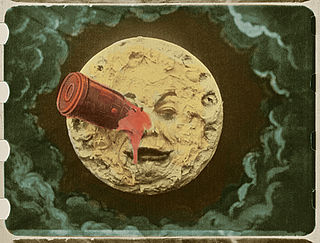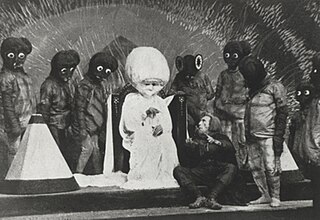
Scientific romance is an archaic, mainly British term for the genre of fiction now commonly known as science fiction. The term originated in the 1850s to describe both fiction and elements of scientific writing, but it has since come to refer to the science fiction of the late nineteenth and early twentieth centuries, primarily that of Jules Verne, H. G. Wells and Arthur Conan Doyle. In recent years the term has come to be applied to science fiction written in a deliberately anachronistic style as a homage to or pastiche of the original scientific romances.

From the Earth to the Moon: A Direct Route in 97 Hours, 20 Minutes is an 1865 novel by Jules Verne. It tells the story of the Baltimore Gun Club, a post-American Civil War society of weapons enthusiasts, and their attempts to build an enormous Columbiad space gun and launch three people — the Gun Club's president, his Philadelphian armor-making rival, and a French poet — in a projectile with the goal of a Moon landing. Five years later, Verne wrote a sequel called Around the Moon.

First Men in the Moon is a 1964 British science fiction film, produced by Charles H. Schneer, directed by Nathan Juran, and starring Edward Judd, Martha Hyer and Lionel Jeffries. The film, distributed by Columbia Pictures, is an adaptation by screenwriter Nigel Kneale of H. G. Wells' 1901 novel The First Men in the Moon.

The Moon has appeared in fiction as a setting since at least classical antiquity. Throughout most of literary history, a significant portion of works depicting lunar voyages has been satirical in nature. From the late 1800s onwards, science fiction has successively focused largely on the themes of life on the Moon, first Moon landings, and lunar colonization.

Voyage: Inspired by Jules Verne is a point-and-click adventure game with pre-rendered graphics, developed by Kheops Studio and published by The Adventure Company for the PC in 2005. The game's story focuses on a French adventurer's journey to the Moon in the 19th century, and the ancient lunar civilization he subsequently finds.

Subterranean fiction is a subgenre of adventure fiction, science fiction, or fantasy which focuses on fictional underground settings, sometimes at the center of the Earth or otherwise deep below the surface. The genre is based on, and has in turn influenced, the Hollow Earth theory. The earliest works in the genre were Enlightenment-era philosophical or allegorical works, in which the underground setting was often largely incidental. In the late 19th century, however, more pseudoscientific or proto-science-fictional motifs gained prevalence. Common themes have included a depiction of the underground world as more primitive than the surface, either culturally, technologically or biologically, or in some combination thereof. The former cases usually see the setting used as a venue for sword-and-sorcery fiction, while the latter often features cryptids or creatures extinct on the surface, such as dinosaurs or archaic humans. A less frequent theme has the underground world much more technologically advanced than the surface one, typically either as the refugium of a lost civilization, or as a secret base for space aliens.
Science fiction opera is a subgenre of science fiction. It refers to operas whose subject-matter fits in the science fiction genre. Like science-fiction literature, science-fiction operas may be set in the future and involve spaceflight or alien invasion. Other science-fiction operas focus on a dystopian view of the future. Like Lorin Maazel's opera 1984, they may be based on a previously written science fiction book.

The First Men in the Moon is a 1919 black-and-white silent film, directed by Bruce Gordon and J. L. V. Leigh. The film was based on H. G. Wells' 1901 science fiction novel The First Men in the Moon.

Around the Moon, also translated as Circling the Moon and All Around the Moon, is the sequel to Jules Verne's 1865 novel, From the Earth to the Moon. It is a science fiction tale which continues the trip to the Moon that was only begun in the first novel. Later English editions sometimes combined the two under the title From the Earth to the Moon and Around It.

Jules Verne's Rocket to the Moon is a 1967 British science fiction comedy film directed by Don Sharp and starring Burl Ives, Troy Donahue, Gert Fröbe and Terry-Thomas.
The Hollow Moon and the closely related Spaceship Moon are pseudoscientific hypotheses that propose that Earth's Moon is either wholly hollow or otherwise contains a substantial interior space. No scientific evidence exists to support the idea; seismic observations and other data collected since spacecraft began to orbit or land on the Moon indicate that it has a solid, differentiated interior, with a thin crust, extensive mantle, and a dense core which is significantly smaller than Earth's.

From the Earth to the Moon is a 1958 American Technicolor science fiction film, produced by Benedict Bogeaus, directed by Byron Haskin, that stars Joseph Cotten, George Sanders, and Debra Paget. Production of the film originated at RKO Pictures, but when RKO went into bankruptcy, the film was acquired and released by Warner Brothers.

The First Men in the Moon, also promoted as H. G. Wells' The First Men in the Moon, is a 2010 television drama written by Mark Gatiss, directed by Damon Thomas, that stars Gatiss as Cavor and Rory Kinnear as Bedford, with Alex Riddell, Peter Forbes, Katherine Jakeways, Lee Ingleby and Julia Deakin. The First Men on the Moon was first broadcast on 19 October 2010 on BBC Four. It is an adaptation of H. G. Wells' 1901 science fiction novel of the same name. This is the third collaboration between Thomas and Gatiss, and the first film to be produced by their production company Can Do Productions.
French science fiction is a substantial genre of French literature. It remains an active and productive genre which has evolved in conjunction with anglophone science fiction and other French and international literature.

The War of the Worlds is a science fiction novel by English author H. G. Wells. It was written between 1895 and 1897, and serialised in Pearson's Magazine in the UK and Cosmopolitan magazine in the US in 1897. The full novel was first published in hardcover in 1898 by William Heinemann. The War of the Worlds is one of the earliest stories to detail a conflict between humankind and an extraterrestrial race. The novel is the first-person narrative of an unnamed protagonist in Surrey and his younger brother who escapes to Tillingham in Essex as London and southern England is invaded by Martians. It is one of the most commented-on works in the science fiction canon.

Trylogia Księżycowa is a trilogy of science fiction novels by the Polish writer Jerzy Żuławski, written between 1901 and 1911. It has been translated into Russian, Czech, German, English and Hungarian, and has been reprinted several times in Poland. They are his best-known works.

Space travel, or space flight is a classic science-fiction theme that has captivated the public and is almost archetypal for science fiction. Space travel, interplanetary or interstellar, is usually performed in space ships, and spacecraft propulsion in various works ranges from the scientifically plausible to the totally fictitious.

A Plunge into Space is an 1890 science fiction novel by Irish author Robert Cromie. It describes a voyage to Mars, where Earthlings find a utopia that is so perfect as to be boring. It received mostly positive reviews upon release and likely sold well. The second edition was published in 1891 with a preface attributed to the French science fiction author Jules Verne; modern scholars have concluded that it was likely written by somebody else. Cromie later accused fellow writer H. G. Wells of plagiarising key plot elements from the book for his 1900–1901 serial The First Men in the Moon; Wells denied ever having heard of Cromie or the book.

Cavorite is a fictional material first depicted by H. G. Wells in The First Men in the Moon, a 1901 scientific romance. Developed by Cavor, a reclusive physicist, it has the ability to negate the force of gravity, enabling him and a businessman named Bedford to travel to the Moon using a spherical spacecraft propelled by Cavorite blinds. The material was later referenced in numerous works of science fiction media, and its theoretical implications have been discussed by critics.

















